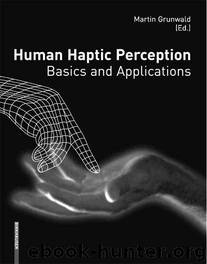Human Haptic Perception: Basics and Applications by Martin Grunwald

Author:Martin Grunwald [Grunwald, Martin]
Language: eng
Format: epub
Published: 2009-02-19T13:40:00+00:00
FIGURE 1. WORKING MODEL: DEVELOPMENTAL RELATION OF HAPTIC OBJECT EXPLORATION AND OBJECT WORDS
Selected readings
Baranek GT, Foster LG, Berkson G (1997) Tactile defen- sivness and stereotyped behaviors. Am J Occup Ther 51: 91-95
Royeen C, Mu K (2003) Stability of tactile defensiveness across cultures: European and American children's responses to the Touch Inventory for Elementary School Aged Children (TIE). Occup Ther Int 10: 165-174
Summary
Haptic processing subserve perception and action. During the first year of life, an infant's developing perceptual, motor and cognitive capabilities are coupled. Touch experiences are largely involved in cognitive development. Infants can perceive and understand the physical world with their hands alone.
Object names map to physical objects; they appear to be the most prevalent words in infants' early lexicons in the period of single-word utterances. The nature of their representation is complex. A concept is formed by transforming a sensorimotor schema into an image-schema. Conceptual knowledge is the most important aspect in how to generalise an object's name. Concerning the haptic system for word-learning, it is absolutely essential in the cognitive canon of modal representation for non-verbal categorisation, since infants interactively integrate object information from all sensory modes, especially the haptic mode - the first functioning system in utero is touch. Haptics offer a sensorimotor organising structure for non-verbal categorisation in early learning of object words. Because objects are discrete, they are more easily conceptualized.
There are at this time no plausible correlational hypotheses for any other types of word and object categorisation. Verbs enter the individual vocabulary much later than nouns and at a slower rate [4], since it is harder to form concepts for actions as opposed to objects. Semantic representation of objects and actions are different, because noun-meaning is more restrictive than verb-meaning. Compared to objects, actions are intangible and transient. The relationship between linguistic input and non-linguistic categorisation has not been sufficiently specified.
Download
This site does not store any files on its server. We only index and link to content provided by other sites. Please contact the content providers to delete copyright contents if any and email us, we'll remove relevant links or contents immediately.
Periodization Training for Sports by Tudor Bompa(8168)
Why We Sleep: Unlocking the Power of Sleep and Dreams by Matthew Walker(6618)
Paper Towns by Green John(5087)
The Immortal Life of Henrietta Lacks by Rebecca Skloot(4525)
The Sports Rules Book by Human Kinetics(4288)
Dynamic Alignment Through Imagery by Eric Franklin(4115)
ACSM's Complete Guide to Fitness & Health by ACSM(3987)
Kaplan MCAT Organic Chemistry Review: Created for MCAT 2015 (Kaplan Test Prep) by Kaplan(3939)
Introduction to Kinesiology by Shirl J. Hoffman(3721)
Livewired by David Eagleman(3682)
The Death of the Heart by Elizabeth Bowen(3551)
The River of Consciousness by Oliver Sacks(3535)
Alchemy and Alchemists by C. J. S. Thompson(3448)
Bad Pharma by Ben Goldacre(3354)
Descartes' Error by Antonio Damasio(3229)
The Emperor of All Maladies: A Biography of Cancer by Siddhartha Mukherjee(3062)
The Gene: An Intimate History by Siddhartha Mukherjee(3046)
The Fate of Rome: Climate, Disease, and the End of an Empire (The Princeton History of the Ancient World) by Kyle Harper(3003)
Kaplan MCAT Behavioral Sciences Review: Created for MCAT 2015 (Kaplan Test Prep) by Kaplan(2936)
